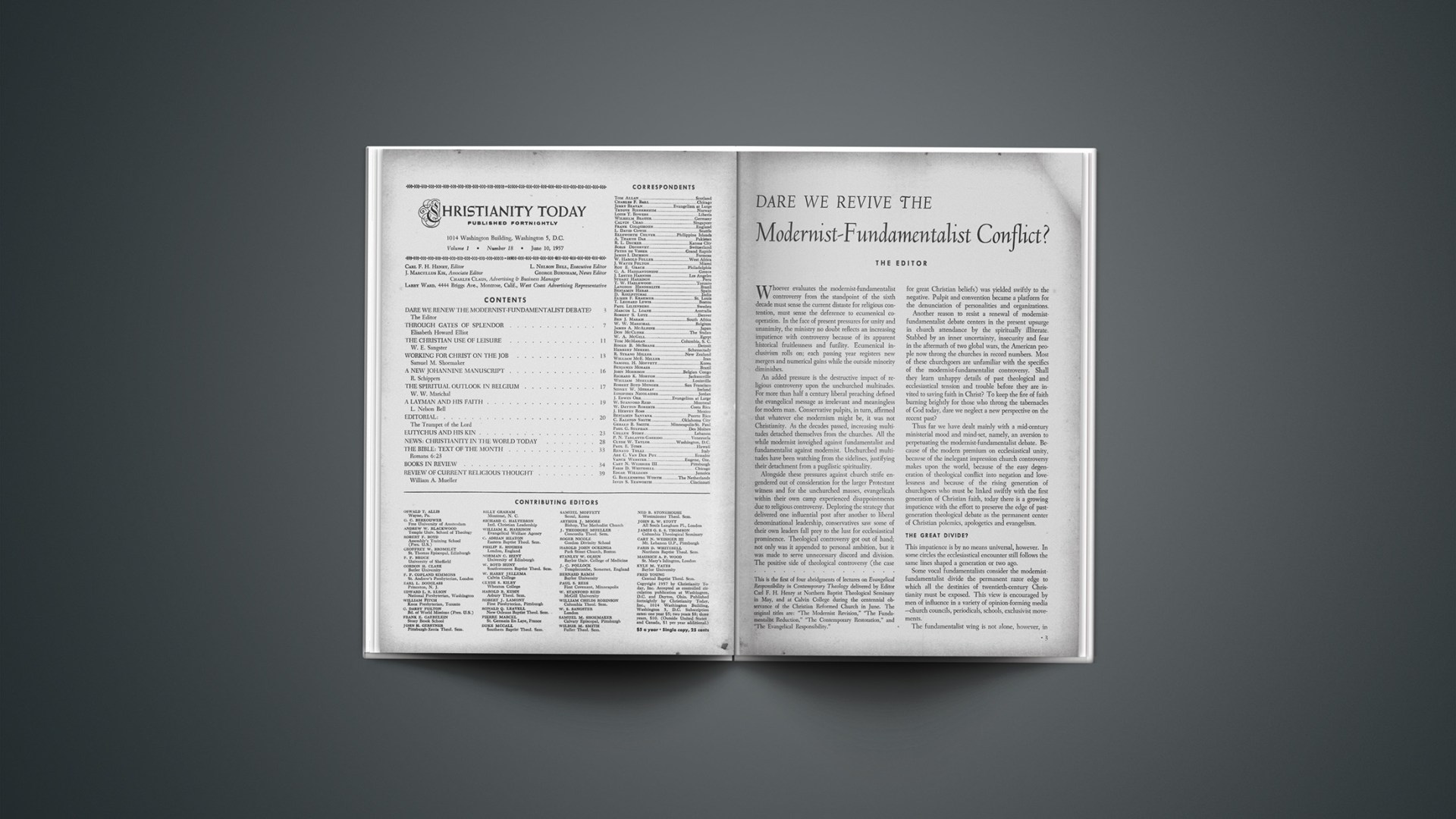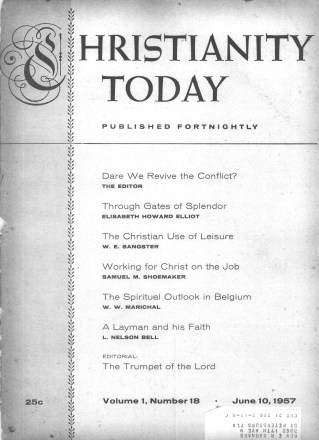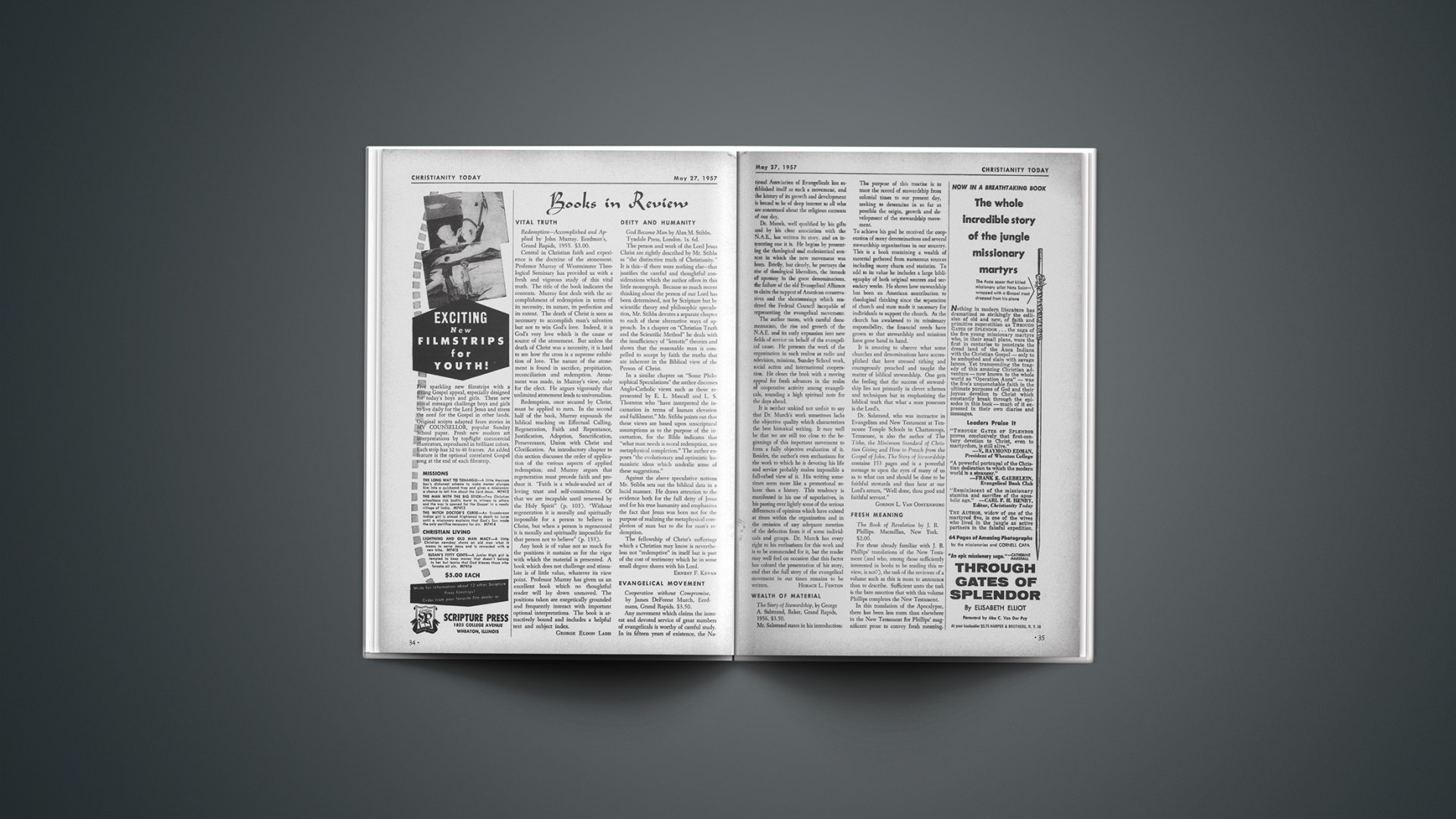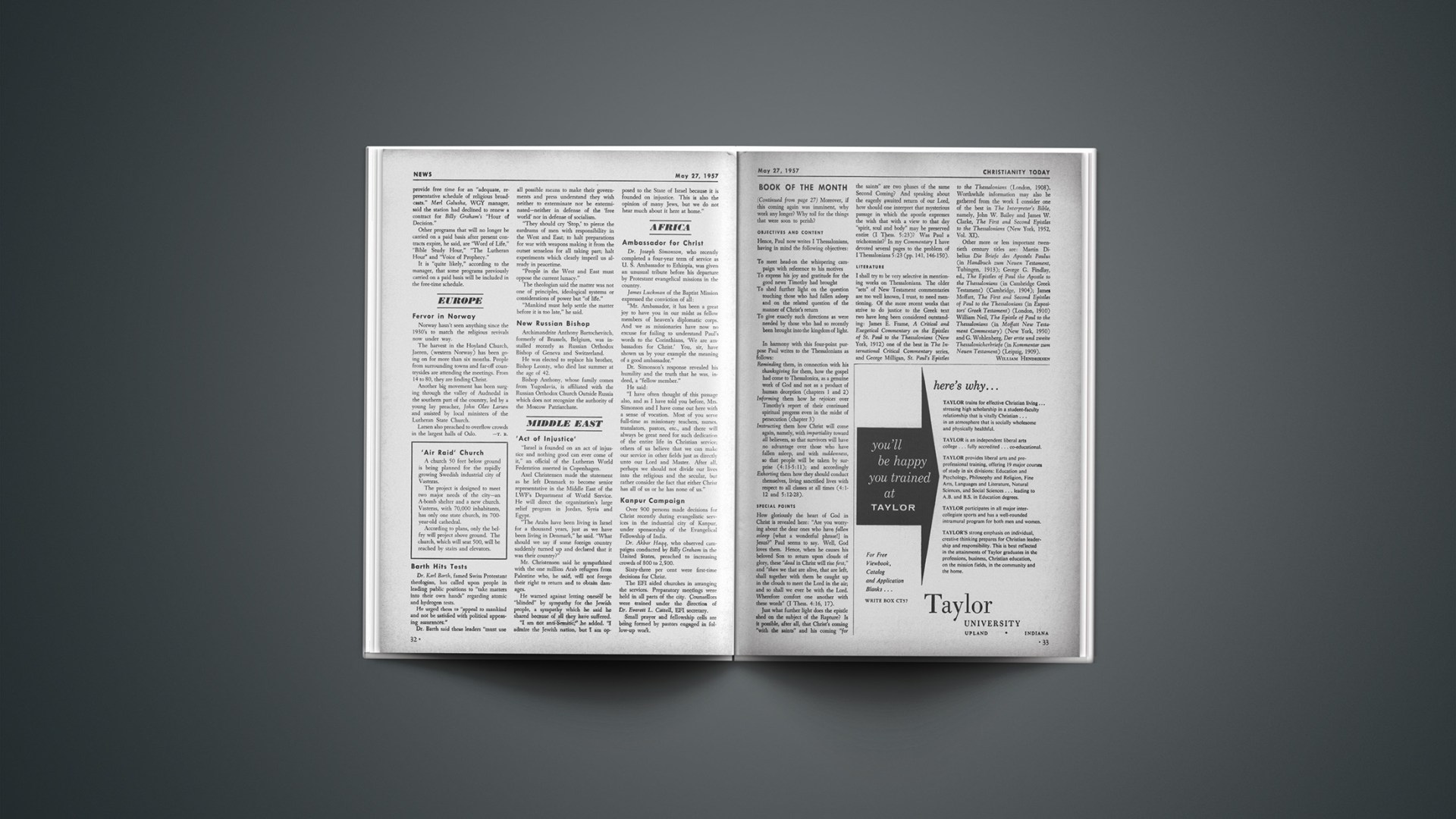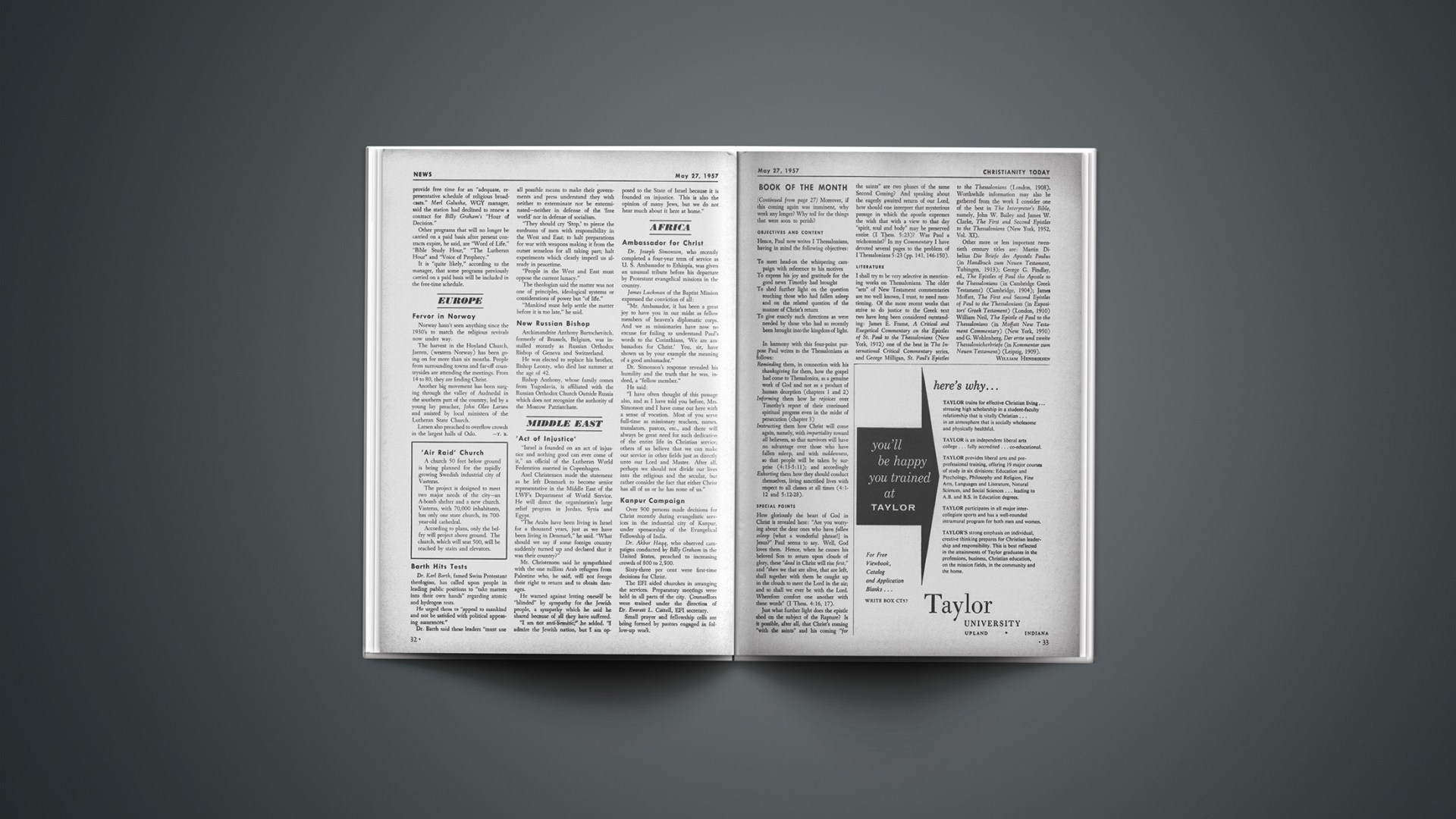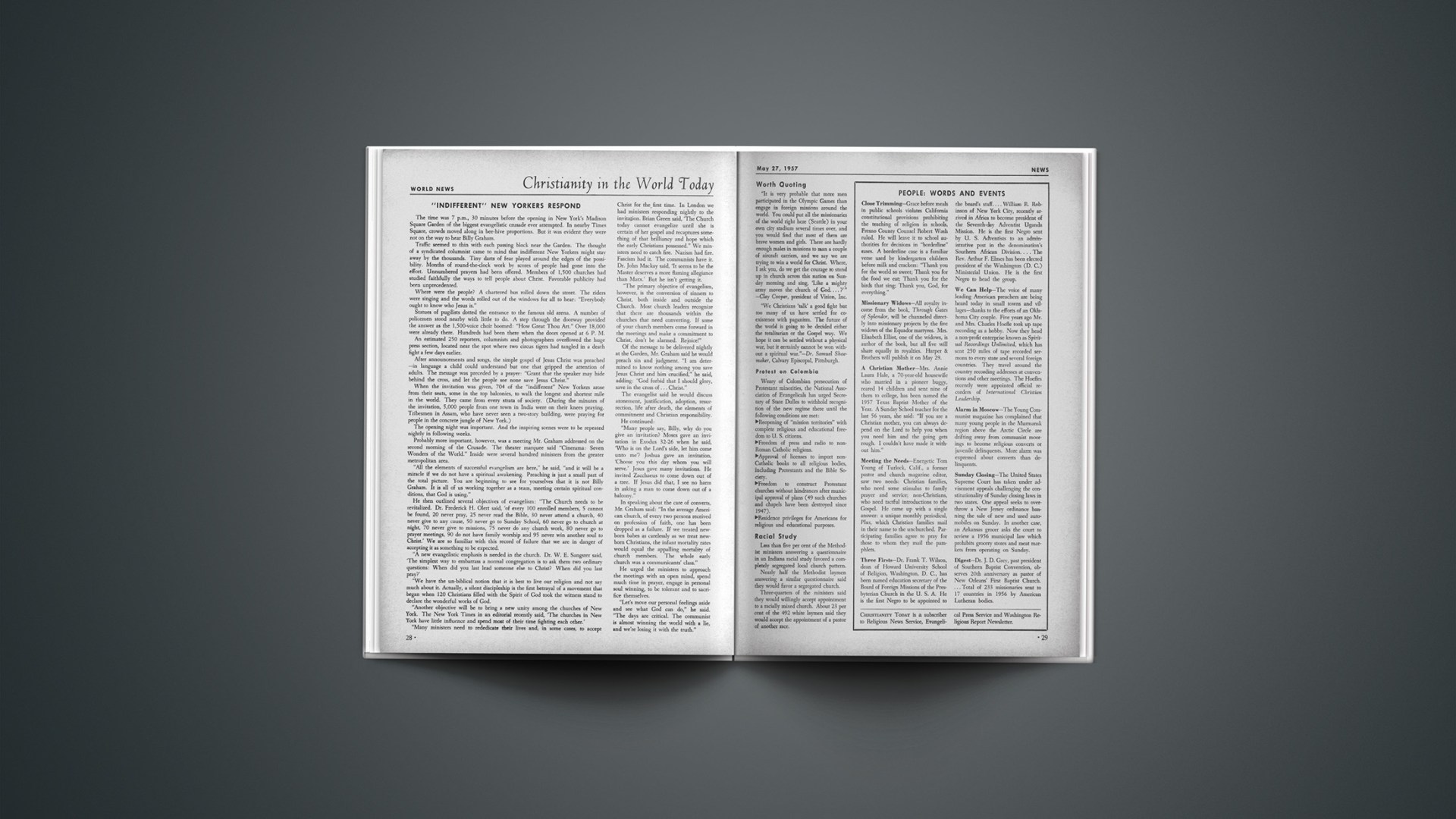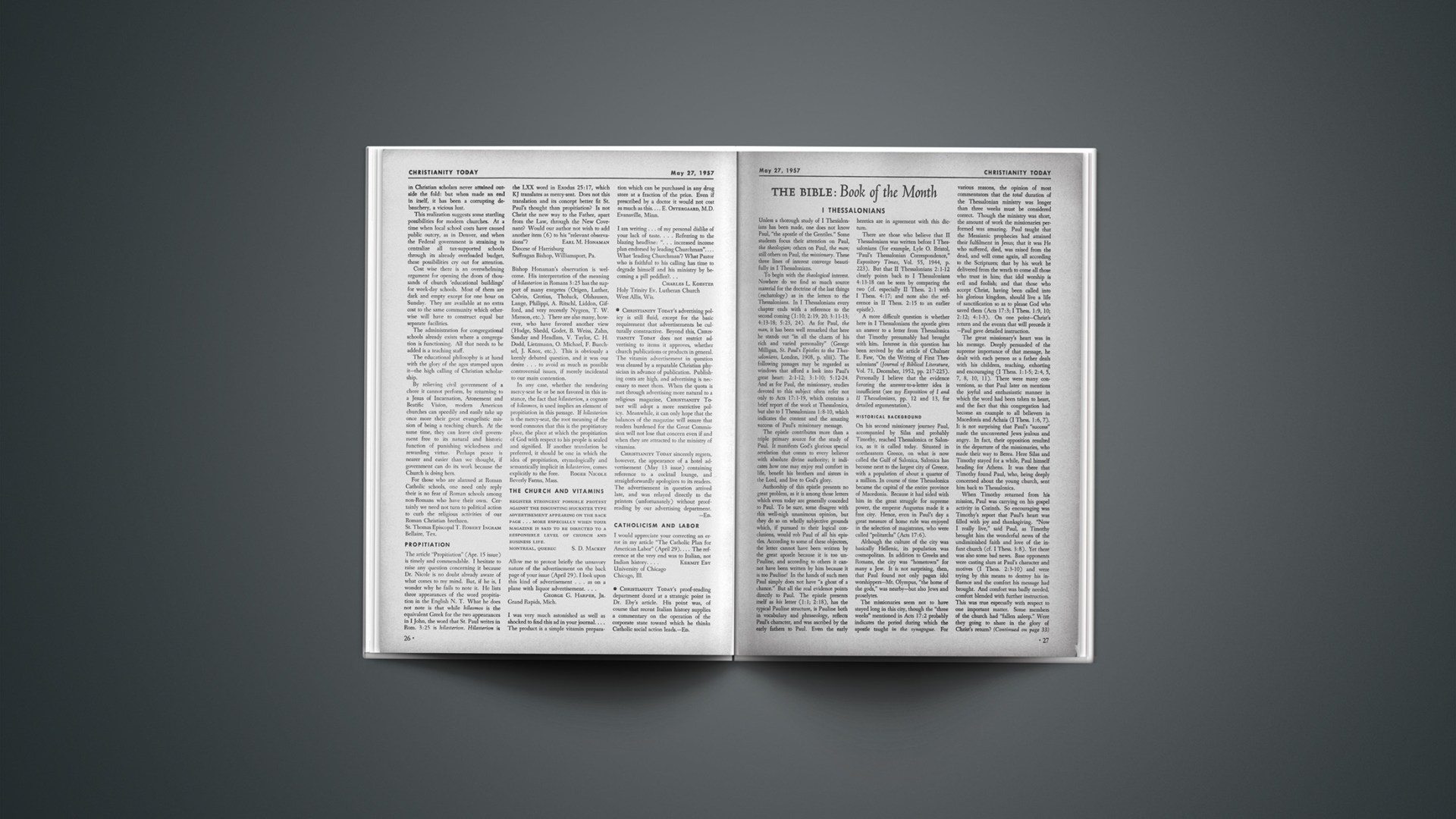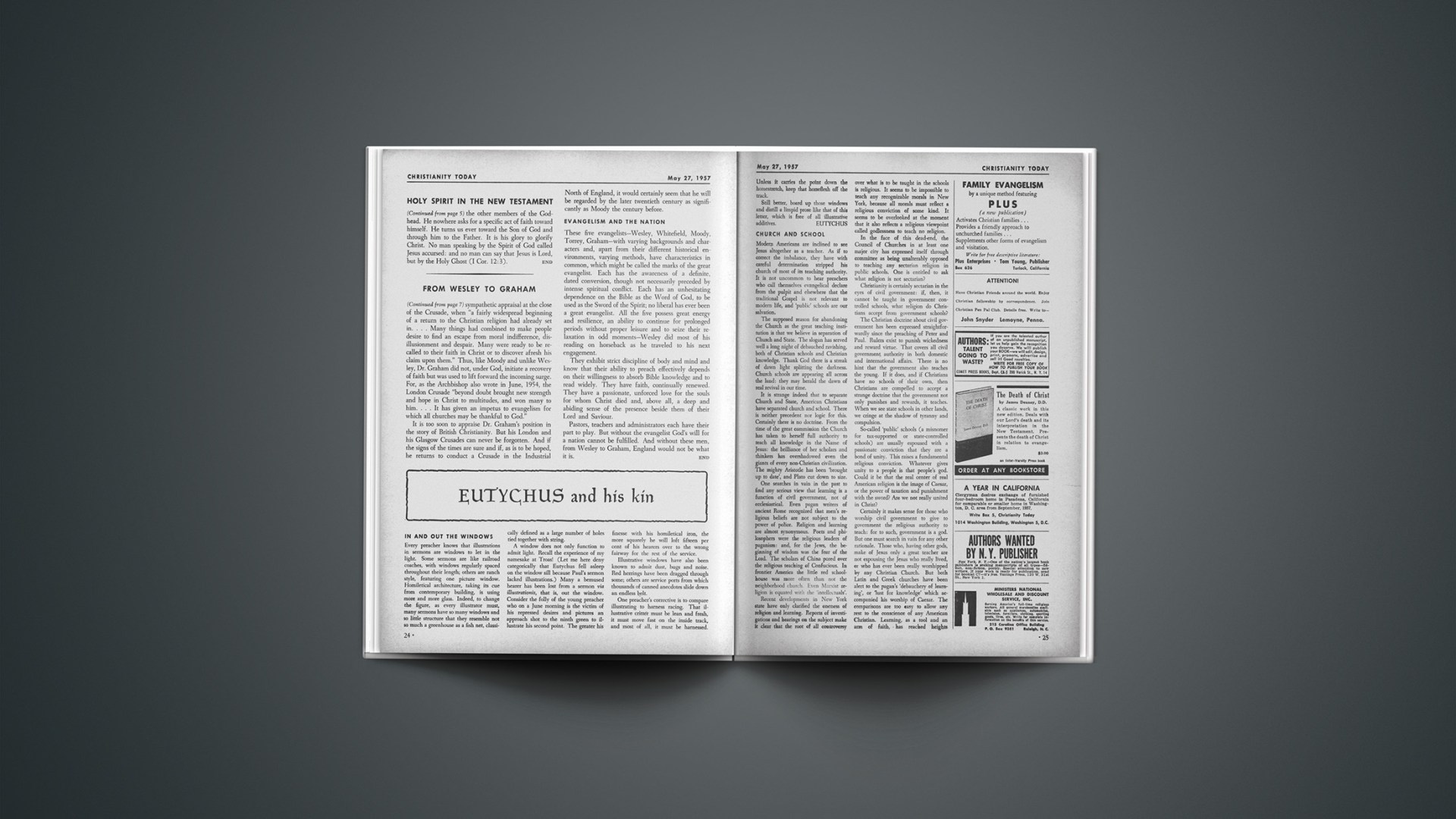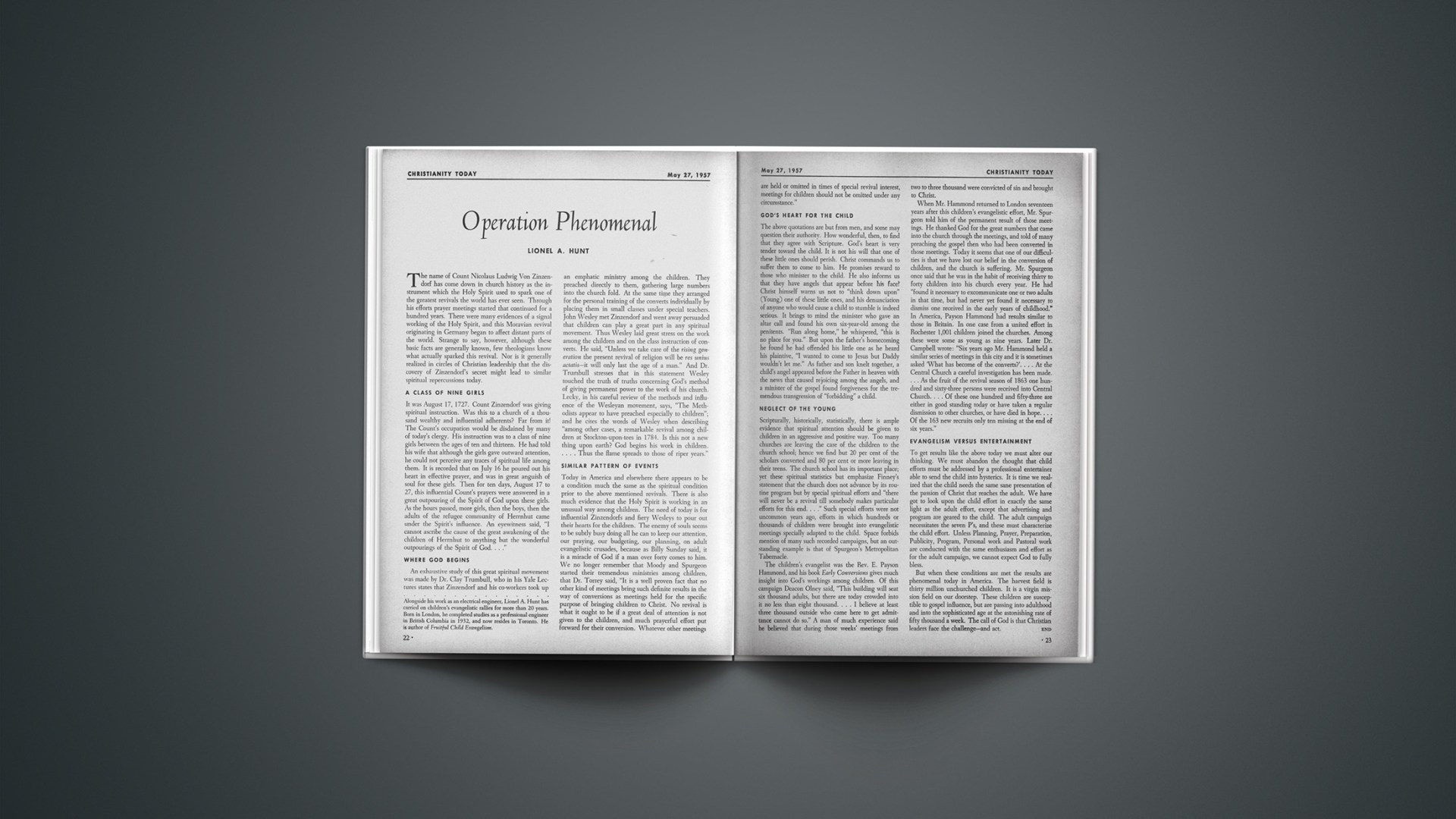Whoever evaluates the modernist-fundamentalist controversy from the standpoint of the sixth decade must sense the current distaste for religious contention, must sense the deference to ecumenical cooperation. In the face of present pressures for unity and unanimity, the ministry no doubt reflects an increasing impatience with controversy because of its apparent historical fruitlessness and futility. Ecumenical inclusivism rolls on; each passing year registers new mergers and numerical gains while the outside minority diminishes.
An added pressure is the destructive impact of religious controversy upon the unchurched multitudes. For more than half a century liberal preaching defined the evangelical message as irrelevant and meaningless for modern man. Conservative pulpits, in turn, affirmed that whatever else modernism might be, it was not Christianity. As the decades passed, increasing multitudes detached themselves from the churches. All the while modernist inveighed against fundamentalist and fundamentalist against modernist. Unchurched multitudes have been watching from the sidelines, justifying their detachment from a pugilistic spirituality.
Alongside these pressures against church strife engendered out of consideration for the larger Protestant witness and for the unchurched masses, evangelicals within their own camp experienced disappointments due to religious controversy. Deploring the strategy that delivered one influential post after another to liberal denominational leadership, conservatives saw some of their own leaders fall prey to the lust for ecclesiastical prominence. Theological controversy got out of hand; not only was it appended to personal ambition, but it was made to serve unnecessary discord and division. The positive side of theological controversy (the case for great Christian beliefs) was yielded swiftly to the negative. Pulpit and convention became a platform for the denunciation of personalities and organizations.
Another reason to resist a renewal of modernist-fundamentalist debate centers in the present upsurge in church attendance by the spiritually illiterate. Stabbed by an inner uncertainty, insecurity and fear in the aftermath of two global wars, the American people now throng the churches in record numbers. Most of these churchgoers are unfamiliar with the specifics of the modernist-fundamentalist controversy. Shall they learn unhappy details of past theological and ecclesiastical tension and trouble before they are invited to saving faith in Christ? To keep the fire of faith burning brightly for those who throng the tabernacles of God today, dare we neglect a new perspective on the recent past?
Thus far we have dealt mainly with a mid-century ministerial mood and mind-set, namely, an aversion to perpetuating the modernist-fundamentalist debate. Because of the modern premium on ecclesiastical unity, because of the inelegant impression church controversy makes upon the world, because of the easy degeneration of theological conflict into negation and lovelessness and because of the rising generation of churchgoers who must be linked swiftly with the first generation of Christian faith, today there is a growing impatience with the effort to preserve the edge of past-generation theological debate as the permanent center of Christian polemics, apologetics and evangelism.
The Great Divide?
This impatience is by no means universal, however. In some circles the ecclesiastical encounter still follows the same lines shaped a generation or two ago.
Some vocal fundamentalists consider the modernist-fundamentalist divide the permanent razor edge to which all the destinies of twentieth-century Christianity must be exposed. This view is encouraged by men of influence in a variety of opinion-forming media—church councils, periodicals, schools, exclusivist movements.
The fundamentalist wing is not alone, however, in the tendency to perpetuate the fundamentalist-modernist controversy. Even some liberals draw the lines of ecclesiastical dispute much as they were drawn a generation ago. They refuse to share Karl Barth’s and Emil Brunner’s sharp criticism of classic liberal theology.
No less a modernist than Harry Emerson Fosdick believes that the fate of Christianity still reduces to a necessary conflict between the old liberalism and fundamentalism. In 1927 Dr. Fosdick’s sermon “Shall the Fundamentalists Win?” made him the storm center of American preaching. Three decades later his highly readable autobiography The Living of These Years (Harper, 1957) spins a halo of self-justification over Dr. Fosdick’s vagabondage and endeavors to vindicate the liberalism to which he raised an altar. Dr. Fosdick guards his cherished liberalism from any need for repentance and radical revision. Likewise his verdict on fundamentalism is identical to that of thirty years ago.
If another example is needed of a modernist tendency to freeze the modernist-fundamentalist debate as the permanent center of ecclesiastical life, we may refer to that influential journal of liberal opinion The Christian Century, which has so unmistakably established fundamentalism as a color word, while vindicating a role of ecclesiastical dignity and respect for such terms as liberalism and modernism. The Century’s outlook today is little different: nothing good can come out of fundamentalism; the hope of the church and of the world is liberalism. Fundamentalist missionaries may die as martyrs, but they are dismissed as misguided; fundamentalist evangelism may strike into the barren churches of our centuries like lightning from heaven, but it is naive and socially irrelevant; fundamentalist scholarship may produce worthy textbooks and religious journals, but they are suspect and dangerous because they are not liberal; fundamentalists may even criticize fundamentalists but unless they defect from evangelical Christianity to liberalism they are still unacceptable.
Essence Of Christianity
The modernism of the past generation is therefore still regarded as the essence of Christianity. Liberalism thus confronts contemporary Christianity once again with two important and interrelated issues: (1) Is modernism acceptable as expressive of Christianity? and (2) Is the Christian church ideally inclusive of both modernists and evangelicals?
Dr. Fosdick gives us a recent answer to these questions, but it is not new. He describes himself as an “evangelical liberal.” And he so defines the term “tolerance” as virtually to mean the acceptance “of a church inclusive enough to take in both liberals and conservatives without either trying to drive the other out” (The Living of These Years, p. 145).
Today, on the other hand, the contrast between modernism and evangelical Christianity is being sketched anew from a quite different standpoint by theologians of former modernist sympathies to show the radical perversion of biblical Christianity of which classic liberalism was guilty.
Secondary Criticisms
Modern churchmen who permit only secondary criticisms of classic liberal theology make its adequacy a contemporary issue through continued espousal. Dr. Fosdick himself enumerates certain criticisms: liberalism adjusted Christian thought to the standard of secular culture, so that “the center of gravity was not in the gospel but in the prevalent intellectual concepts of our time” (p. 245); it was “too blind to the tragic sinfulness and plight of man” (p. 248); “it took too negative a view of the Bible” (p. 243). Although the first of these criticisms would be sufficient to discredit modernism as the bearer of the essence of Christianity, Dr. Fosdick nevertheless refuses to bring under vigorous criticism the liberalism that he represented. While conceding that he “took the optimistic color of our generation” (p. 237), he declines to be classified with main-stream liberalism, or rather, with those “extreme” liberals whose views are now under fire (p. 231). There were varieties of liberalism, and his variety, says Dr. Fosdick, did not share these objectionable features which later invited a criticism of liberalism as secular and non-Christian. He identifies himself with that “very considerable number” of liberals who rejected “automatic, inevitable social progress” (p. 237); who denied that the “Kingdom of God could fully come in human history on this planet” (p. 239); who refused to reduce Christianity to mere ethicism but widened it rather to include Jesus’ world view and his faith in God as well as his morals (p. 242). While extreme liberalism doubtless propounded an excessive divine immanence, Dr. Fosdick defends his as the New Testament view (p. 253). Moreover, notwithstanding European criticism and rejection for more than two decades of Dr. Fosdick’s diminution of divine revelation to prophetic initiative and insight, he evades any acknowledged support of liberalism’s exaggerated confidence in human reason (p. 256). Although writing appreciatively of neo-supernaturalism’s stress on a divine initiative in our religious experience (p. 236) and on the necessity and primacy of God’s self-revelation (p. 256), and although voicing his debt to Niebuhr for the emphasis that even our best good is corroded by egocentricity and pride, Dr. Fosdick nonetheless repeatedly declares his own brand of liberalism (p. 251) without need of neo-orthodox revision, since he did not join the “optimistic extremes” of other modernists.
Evangelicals will not lament some dangers (such as an excessive divorce of faith and reason, an unhealthy pessimism) that Dr. Fosdick senses in neo-supernaturalism. But protest must be made when he protects Fosdickian liberalism from criticism, when he insists that even neo-supernaturalism is best sanctified by liberalism and when he concedes that neo-supernaturalism attracts him in its disavowal of any final theology. Herein an unrepentant liberalism of the 1920’s is seeking immortality for itself in the 1950’s.
An Unchanging Modernism?
Curiously enough, Dr. Fosdick throughout his lifetime has professed the conditioning of every generation’s theology by its social matrix. Therefore, each theology sooner or later is destined for discard (p. 232). “Static orthodoxies,” he tells us, “are a menace to the Christian cause” (p. 230). “Theologies are psychologically and sociologically conditioned” (p. 231). “Theological trends … are partial, contemporary” (p. 232). “Dogmatism in theology, whether ‘liberal’ or ‘orthodox’ is ridiculous” (p. 231).
In view of Dr. Fosdick’s representations of theology as necessarily relative and changing, is it not incredible that he should wish for his own views a durability and an exemption from criticism which he denies to the views of others? Is it not amazing that Dr. Fosdick is unwilling to refer his own prejudices to this principle of inevitable change, which he has so confidently invoked against the orthodoxy of the past? It was on the ground of the supposed inevitability of theological change that Dr. Fosdick had in fact contended that “creedal subscription to the ancient confessions of faith is a practice dangerous to the welfare of the church and to the integrity of the individual conscience” and, moreover, is “hampering to the free leadership of the Spirit” (p. 172).
Dr. Fosdick even seems to arrogate to his views a veiled prophecy of finality: “neither the extremes to which liberalism often went nor the extremes to which neo-orthodoxy goes today will be the final word” (p. 265). Are we not, in context, to regard the stable view of Dr. Fosdick as that final word? Yet has he not elsewhere firmly disowned the possibility of any final word in theology? Are we not to expect that, as in the mid-20’s he urged the church to go beyond fundamentalism, and as in the mid-30’s he pleaded that “The Church Must Go Beyond Modernism,” so in the mid 50’s he would require that it go beyond Fosdick?
Dr. Fosdick himself complains that other liberals, after rejecting biblical positions, too often fell prey to a static orthodoxy of their own (p. 246). Assertedly, there is no genuine protection from theological relativism. Yet hesitancy and half-heartedness characterize his own application of this concept. Now and then Dr. Fosdick ventures to write not merely of “the basic Christian experiences,” but of “revelations of truth”; indeed, he insists that he himself maintains “the timeless values and truths of the gospel” (p. 147), and that liberals agree with the historic denominations “in the abiding substantial truths” they support (p. 163). The impression is unavoidable that Dr. Fosdick more consistently observed the limits of his approach when in decades past he spoke of theory rather than of truth in words like these: “In theology I hold the opinions which hundreds of … ministers hold” (p. 172). However halting the application to his personal positions, Dr. Fosdick has cut himself off in principle from any privilege to propose lasting truth.
This fact puts us on guard when we overhear Dr. Fosdick, quite indifferent to the limitations of his theory of knowledge, pleading with modernists to stop conforming Christ to contemporary culture but rather to challenge modern culture in the name of Christ (p. 246). Elsewhere he pleads for “well-thought-out, positive statements of liberal convictions in the realm of Christian faith” (p. 243). But where, within Dr. Fosdick’s approach, is the minister to find fixed and final concepts and ideas wherewith to challenge the prevalent intellectual concepts of the times? If the liberal minister is to avoid both a revealed theology and an adjustment to contemporary culture, in the name of what is he to discriminate permanent truths from impermanent opinions? For not only are dogmatic certainty and static creed elsewhere affirmed to be unnecessary and impossible, but dogmatism is dogmatically alleged to be a source of religious ruin (p. 233).
Prevailing Prejudices
Dr. Fosdick’s autobiography reflects the speculative assumptions that determine his readiness to delete the sacred doctrines of evangelical Christianity from his conception of vital religion. Two such controlling prejudices, contradictive of biblical Christianity, stand in the forefront: (1) the notion that man’s experience of God is immediate, without a necessary dependence upon past mediation; and (2) the notion of the human mind’s incompetence to grasp spiritual realities. It is not amiss to comment briefly.
Dr. Fosdick writes of “direct, immediate, personal experience as the solid ground for assurance” (p. 234). Stated this bare way, we seem to have here the reiteration of an important New Testament emphasis, namely, that Christianity involves no mere second-hand relationship to God. Assurance of salvation is not suspended upon the word of some priest or hierarchy, but rather is subjectively ascertainable through the immediate witness of the Spirit. Actually, however, Dr. Fosdick virtually excludes any historically mediated revelation and redemption in his emphasis on man’s present relationship with God. The implications stand out when we inquire into Dr. Fosdick’s conception of the Gospel. He tells us: “The essence of Christianity is incarnate in the personality of the Master, and it means basic faith in God, in the divinity revealed in Christ, in personality’s sacredness and possibilities and in the fundamental principles of life’s conduct which Jesus of Nazareth exhibited” (p. 269). Read these words often as one will, one cannot escape the conviction that Dr. Fosdick’s statement contradicts the New Testament view that the essence of Christianity is the good news of the saving death and resurrection of Jesus Christ for doomed sinners (cf. 1 Cor. 15:1–4). Instead of depicting Jesus Christ as the redeemer of all men, Dr. Fosdick tells us simply that Jesus of Nazareth was the first and finest Christian.
Dr. Fosdick’s restriction of the relevance of reason in the spiritual world accounts for his concessions to metaphysical agnosticism; this weakness the newer neo-supernaturalistic views carry over from the older modernist tradition. It is curious to note Dr. Fosdick’s apprehension over Barth’s divorcing of revelation and reason, while yet he approves Barth’s emphasis that “our concepts are not adequate to grasp this treasure.” Nonetheless, Dr. Fosdick disallows us any final theological knowledge. Curiously, he tells us: “Ideas of God change and ought to, but that fact does not mean that anything has happened to God [How Dr. Fosdick came by this latter bit of fixed information he does not inform us].” Nowhere does Dr. Fosdick harmonize his own incidental references to enduring spiritual truths with his denial of the competency of reason in the spiritual world, and with the consequent assertion of theological relativity. While he appeals deferentially to “the life and words of the historic Jesus” (p. 247), he does not indicate why even those teachings of Christ which pass Dr. Fosdick’s censorship are exceptions to the rule that divine truths cannot be infallibly grasped and communicated in the dimension of humanity.
Dr. Fosdick’s affirmation of the theological relevance of last-generation liberalism comes as a keen disappointment to many evangelical leaders. Prone to assume that liberalism had been chastened, curbed and forced to abandon its defenses by the drift of the times, if not by the authority of biblical revelation, these evangelicals will find in Dr. Fosdick’s The Living of These Days a revelation that he has not really lived through our era with theological awareness; he moves still within the gates of a romanticized experiential Christianity isolated from the realities of history. Casting the fortunes of liberalism in this unrepentant mold will not only evoke wide disappointment, but it will provoke the conviction that the time for theological controversy is once again upon us.
Irrelevance Of Modernism
Evangelicals are not alone in their negative verdict on classical liberalism, Dr. Fosdick’s species included. Influential liberal circles see the necessity of superseding the Fosdickian views if Protestant theology in the 50’s is to maintain its vitality. In fact, the whole initiative in theology is now shaped by leaders who dismiss Fosdick’s The Modern Use of the Bible as a mirror of outdated prejudices. They do not share his reliance on the relevance of classic liberalism but have already conceded the irrelevance even of the Fosdickian version.
A sound theological instinct supports their uneasiness over the classic liberal position. Even at best liberalism reflected the invasion of a secular spirit. It exaggerated God’s immanence, minimized man’s sinfulness, concealed Christ’s supernaturalness and the centrality of his redemptive work, attached utopian expectations to history and ignored the task of evangelism. For half a generation, most centers of the old liberal thought have been compromising, adjusting and refurbishing the views of a generation ago. Their theologians and ministers are eager to get beyond the modernist-fundamentalist controversy. For them classic liberal theology was too strongly leavened with secularism to be cherished as a fixed point of theological debate. The fact that modernism evolved a counter-dogmatics to historic Christianity, a counter-ethics, a counter-ecumenicity, attested the radically different premises with which modernism began. These inevitably spelled out their counter-implications to historic Christianity. That modernism took this course was no reflection on Christianity; it was a commentary, rather, on the fact that modernism quite understood its starting point, rooted in speculation instead of in revelation. What is a reflection on Christianity, however, is that many Protestant leaders did not sense this alien starting point. They chose, rather, to defend it as expressive of the essence of Christianity. Moreover, some influential leaders today still glory in a speculative secular standpoint whose implications are disastrous for Christian faith. Yet neo-supernaturalists like Barth and Brunner have expressed themselves no less pointedly than did J. Gresham Machen, in Christianity and Liberalism.
Barth does not hesitate to speak of modernism as a heresy. “Within the organized unities of the evangelical churches we are faced with the fact of pietistic-rationalistic Modernism” in which, he writes, “we do not recognize faith and the Church,” and in encountering which Christianity is called “to purification, to a rendering of our account, to responsibility.” Over against modernism, “although it has neither been expelled from the evangelical churches nor voluntarily gone over to found a counter-church, we draw the line as definitely as over against Catholicism” (The Doctrine of the Word of God, Vol. I, Part 1, 36 ff.).
In the very year in which Fosdick delivered his great sermon against the fundamentalists, Brunner was delivering a series of lectures in the United States in which he said bluntly: “A first glance at fundamentalism shows its strength to consist in a negative; its criticism of modernism from the standpoint of Christian faith … A fundamentalist, possessed of a reasonably correct knowledge of Christianity, will have little difficulty in proving that the modernist teaches, under the label of Christianity, a religion which has nothing in common with Christianity except a few words, and that those words cover concepts which are irreconcilable with the content of Christian faith” (The Theology of Crisis, p. 9. New York: Charles Scribner’s Sons, 1929). (TO BE CONTINUED)
This is the first of four abridgments of lectures on Evangelical Responsibility in Contemporary Theology delivered by Editor Carl F. H. Henry at Northern Baptist Theological Seminary in May, and at Calvin College during the centennial observance of the Christian Reformed Church in June. The original titles are: “The Modernist Revision,” “The Fundamentalist Reduction,” “The Contemporary Restoration,” and “The Evangelical Responsibility.”

